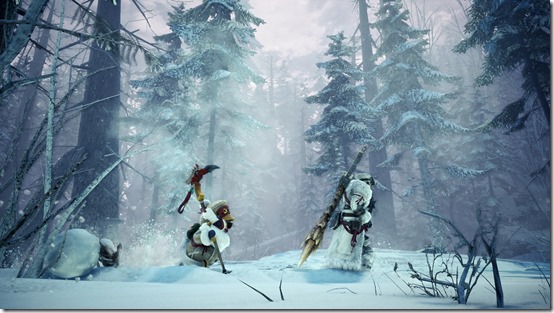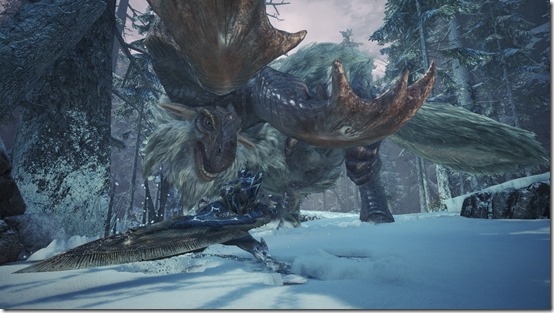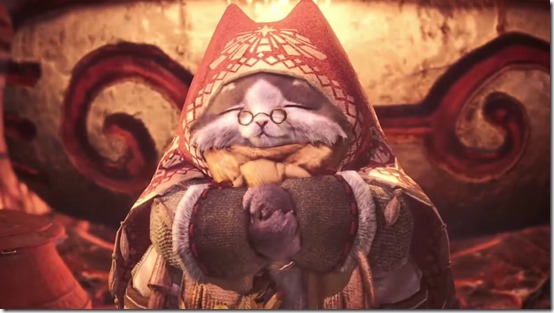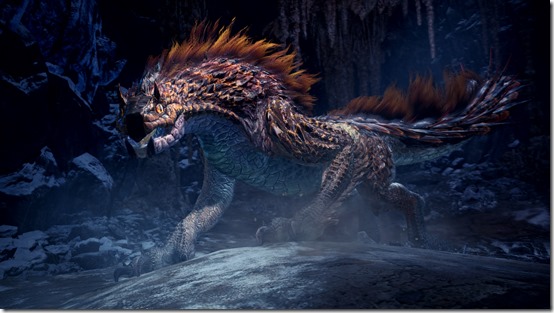Monster Hunter World: Iceborne’s Kaname Fujioka And Daisuke Ichihara Talk About Deciding Which Monsters To Bring Back, Character Designs, And Grammeowster Chef’s Stew
 Monster Hunter World: Iceborne
Monster Hunter World: Iceborne is upon us. Players will be able to head into a frozen biome to hunt both new and old monsters, while also enjoying some help from friendly NPCs, new mechanics, and quality of life changes. Siliconera recently had an opportunity to discuss the expansion with Kaname Fujioka,
Monster Hunter World: Iceborne’s Executive Director and Art Director, and Director Daisuke Ichihara.
Siliconera: What does Hoarfrost Reach take from and build up on past Monster Hunter biomes like Snowy Mountain and Polar Field?
Kaname Fujioka: We wanted to have a fresh approach for the ice and snow in the frozen areas in Iceborne, so there’s actually no stage from the past Monster Hunter games that we referenced. However, in terms of the how the ice appears translucent and the way it shows reflections, we did incorporate some of what we observed from our location research a few years back to the Argentinian glaciers for Monster Hunter 4.
Some Monster Hunter creatures seem to draw heavily from actual animals, with their appearances and behaviors being similar. What inspired the Banbaro and Beotodus and how will we see that represented both in their appearances and personalities?
Fujioka: I’m quite sure Banbaro and Beotodus are probably obvious, but we built our designs and animation with reference to buffalo and sharks, respectively.
We had decided from the early design stages that we wanted Banbaro to be a charging monster that uses its head and horns as the main focus. So with that in mind, large mammalian monsters which use their huge horns dynamically, such as buffalo and rhinoceros, were some of the references.
Beotodus is a monster who dives and keeps half of its body under deep snow. For this monster, we referenced and created its designs from sharks in how it can suddenly jump at you and snowplows for how it swims and slices through the snow.
 Iceborne will bring back certain characters, such as Monster Hunter Generations’ Glavenus and Monster Hunter 3 Ultimate’s Brachydios. How did you decide which creatures, like Glavenus, should come back?
Iceborne will bring back certain characters, such as Monster Hunter Generations’ Glavenus and Monster Hunter 3 Ultimate’s Brachydios. How did you decide which creatures, like Glavenus, should come back?
Daisuke Ichihara: The entire line-up of monsters for the game was very carefully considered, not just specifically bringing back the fan-favorite monsters. The criteria varied, including factors like difficulty levels, selection of elemental features tailored to level designs, types of monsters, diversity of monster bone framework, and popularity with fans.
For
Iceborne, the concept for the fields and ecosystems were already established, so we then made considerations for monsters that would interplay with these settings. For instance, Glavenus appears in Wildspire Waste to have an effect on that ecosystem. Other than the Elder Dragons, the top of the food chain in the Wildspire Waste would be Diablos and Rathian, but they are both flying wyverns, so we made sure that there are other types of monsters with different bone framework to add variety for hunts, and also to threaten their status in the food chain.
What does the design process look like when you decide to create a subspecies character like, say, Viper Tobi-Kadachi and how many steps does it involve between going from deciding which character to use and what to change?
Fujioka: First of all, as the quest rank gets higher, sub-species monsters appear and offer a higher level of difficulty than the original normal species. This isn’t just about a sub-species monsters’ strength, but the difficulty is also affected by its characteristics.
So for example, Viper Tobi-Kadachi, compared to the normal Tobi-Kadachi, was designed so that it’s not just a challenge on its usual merits, but that there’s added difficulty from having to read its movement and position. In addition, we considered the point at which this monster would appear and wanted players to have to factor for status abnormalities once again, so we decided to add poison and paralysis attributes for the subspecies.
As for the design, we wanted to have a contrast from the original blue-white which has a beauty to it, so we referenced and implemented some colors and patterns from poisonous animals.
 The Grammeowster Chef has a very different look from the Meowscular Chef we’re familiar with. What was your goal with this character’s design?
The Grammeowster Chef has a very different look from the Meowscular Chef we’re familiar with. What was your goal with this character’s design?
Fujioka: Seliana is in a cold region, so we wanted to create the canteen to have a warm welcoming atmosphere that you would want to visit many times. Plus, beef stew is a dish that makes the hunter’s mind and body warm from the snowy land!
In contrast to Astera’s rugged wild meat dishes, we thought that the signature dish at Seliana could be a stew which is created with the Grammeowster Chef’s loving care. We wanted a skilled master chef, and decided on a very sweet and charming old grandma.
Lots of Gathering Hub quality of life changes are present, like a blacksmith setting up shop there. How did you prioritize which changes were in and out and decide, "Okay, this has to be here in the expansion?"
Ichihara: The
Monster Hunter series is based around cooperative online multiplayer, so we wanted to enhance this by improving the Gathering Hub. The top priority was being able to access the game cycle within multiplayer, so we focused on the Smithy, Palico management, Bounty management, then the Research Commission and the Argosy Captain. We didn’t bring over every single facility, but rather focused on the most critical options a player may need in a more natural, convenient way.
 How do you feel about the expansion approach, rather than releasing an updated game later, and has it allowed you any additional freedoms or options during development?
How do you feel about the expansion approach, rather than releasing an updated game later, and has it allowed you any additional freedoms or options during development?
Ichihara: Actually, our approach is the opposite. The
Monster Hunter series has released expansion versions as separate titles called “
G” or “
Ultimate” in the past. The biggest advantage on the development side for the “
G” series was that we could make adjustments all the way down to the root of the source code, revisit the difficulty level and evaluate the overall game design.
This time round, we were able to take the same approach to
Iceborne as the expanded “G” versions, so not only did we have an advantage from development, but by not releasing another separate game, we were able to keep the MH: World and
Iceborne expansion communities together.
How has the team reacted to Monster Hunter World setting records for Capcom by selling over 13 million copies and have staff members felt like they has been under any additional pressure as a result?
Ichihara: I think there are people who of course felt proud and those that felt a lot of pressure. It really depends on the individual, but I do think many people feel the increased pressure. From the developer’s point of view, the number of games sold does not necessarily equal the number of people who were satisfied with the game. Although it’s easy to just look at the numbers, our priority as developers is that we want as many people as possible to appreciate the game and have fun. So, we feel pressure to keep making better and better games to make sure we maximize feedback that the game is fun and accessible.













